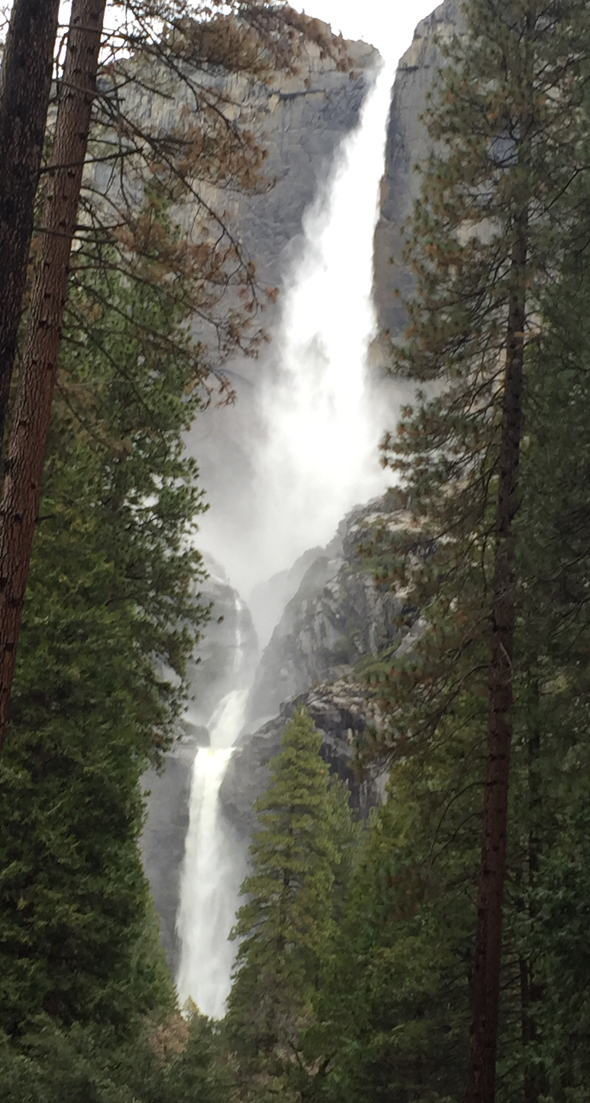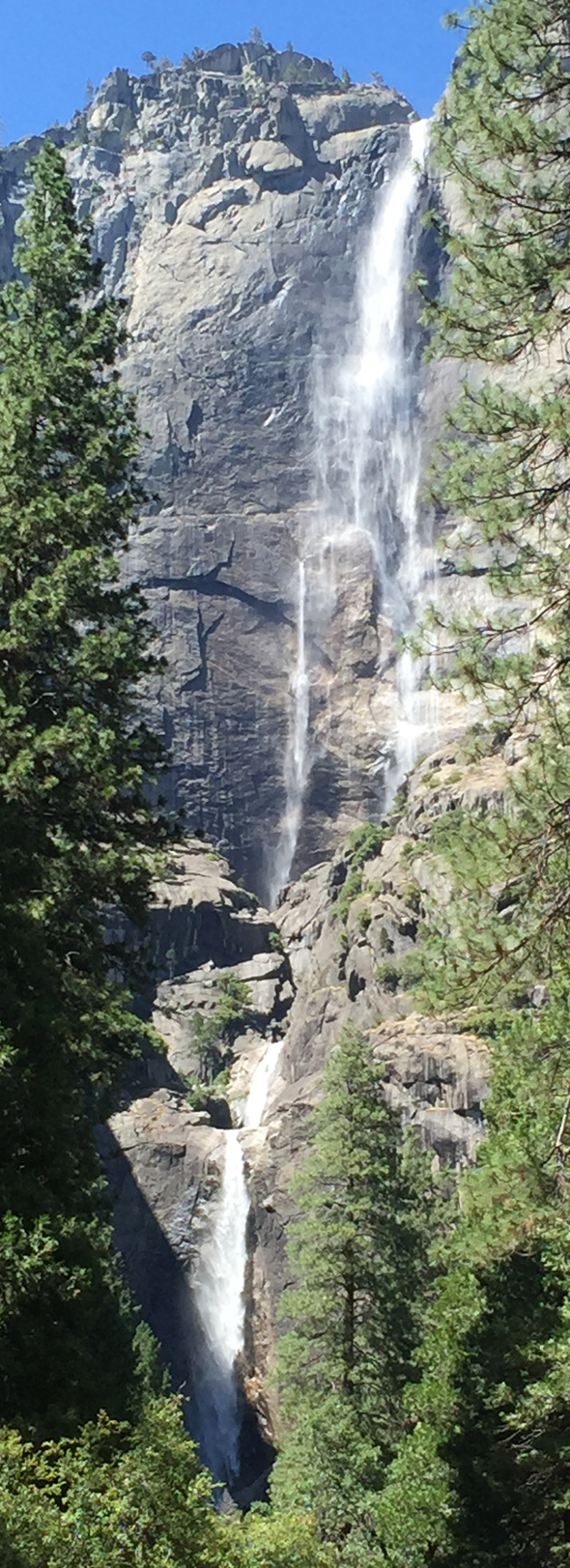I suggest to people that they stop when walking on the pathway to Lower Yosemite Fall, look at the upper fall, imagine it with full flow in the winter and then imagine the wind catching and holding the flow.
(Yosemite Falls, is three falls (three sections). It drops a total of 2,424 feet, almost a half mile. Upper Yosemite Fall drops 1,430 feet, Middle Cascades drops 675 feet, and Lower Yosemite Fall drops 320 feet.) Below and larger sizes at the end of this page, is the view as you walk along:
Conservationist John Muir, who built a cabin in a tree near the base of lower Yosemite Fall in 1869, wrote about a winter storm when this happened and he counted to 190 before the wind stopped holding the water:
“One morning I was awakened by the pelting of pine cones on the roof of my cabin, and found, on going out, that the north wind had taken possession of the valley, filling it with a sea-like roar, and, arousing the pines to magnificent action, made them bow like supple willows. The valley had been visited a short time before by a succession of most beautiful snowstorms, and the floor, and the cliffs, and all the region round about were lavishly laden with winter jewelry. Rocks, trees, the sandy flats and the meadows, all were in bloom, and the air was filled with a dust of shining petals. The gale increased all day, and branches and tassels and empty burs of the silver pine covered the snow, while the falls were being twisted and torn and tossed about as if they were mere wisps of floating mist.
In the morning the great ponderous column of the upper Yosemite Fall, increased in volume by the melting of the snow during a warm spell, was caught by a tremendous blast, bent upwards, torn to shreds, and driven back over the brow of the cliff whence it came, as if denied admission to the valley. This kind of work would be kept up for ten or fifteen minutes, then a partial lull in the storm would allow the vast torrent to arrange its tattered skirts, and come back again to sing on in its accustomed course.
Amid all this rocking and bending and baffling of the waters they were lighted by a steady glare of sunlight, strangely white from spicules of snow crystals. The lower fall, though less exposed, was yet violently swirled and torn and thrashed about in its narrow canyon, and at times appeared as one resplendent mass of iris colors from top to bottom, as if a hundred rainbows had been doubled up into a mass four or five hundred feet in diameter.
In the afternoon, while I watched the upper fall from the shelter of a pine tree, it was suddenly arrested in its descent at a point about half way down, and was neither blown upward nor driven aside, but was simply held stationary in mid air, as if gravitation below that point in the path of its descent had ceased to act. The ponderous flood, weighing hundreds of tons, was sustained hovering, hesitating, like a bunch of thistledown, while I counted 190. All this time the ordinary amount of water was coming over the cliff and accumulating in the air, swedging and widening and forming an irregular cone 700 feet high tapering to the top of the wall, the whole standing still, resting on the invisible arm of the north wind. At length, as if commanded to go on again, scores of arrowy comets shot forth from the bottom of the suspended mass as if escaping from separate outlets.”
![]()
The easiest place to access the pathway he watched this happen from is at Yosemite Valley free shuttle bus stop number six.
Or the path/ trail is almost a straight shot from a Yosemite Lodge pathway through parking lots and across Northside Drive:
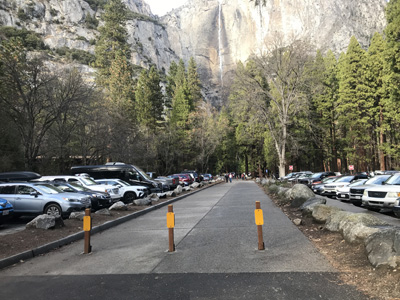
Red red X on the map below shows where the pathway through parking lots ends and then goes across Northside Drive. The darker dotted line above the red X is the pathway section with all three sections of the fall visible.
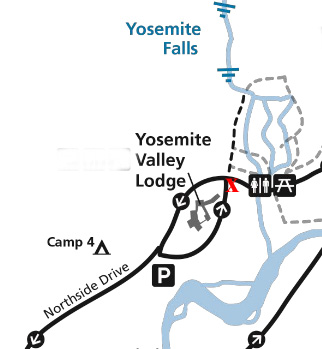
People at the start of that section of the trail /walkway on the far side of Northside Drive from the Lodge:

And see also the hike to the top of Yosemite Falls Upper Yosemite Fall hike
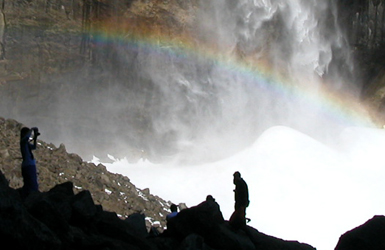
Places to take photos of Yosemite Falls in Yosemite National Park (with maps)
Places to take photos of Half Dome in Yosemite National Park (with maps)
Places to take photos of El Capitan in Yosemite National Park, (with maps)
Places to take pictures of Bridalveil Fall
Places to photograph Staircase falls
________________________________________________
The view of the falls in February from the far left hand portion of the lower Yosemite Falls walkways/trails, an almost straight shot from Yosemite Valley Lodge.
and a view from June with much less water flow:
________________________________________________
The Mountains of California by John Muir can be read at:
http://www.abovecalifornia.com/lib/JohnMuir/MountainCa
or try https://archive.org/details/writingsjohnmuir05muirrich
Can I recommend these chapters?
VII THE GLACIER MEADOWS
XII SIERRA THUNDER-STORMS
XIII THE WATER-OUZEL
The entire text of The Yosemite by John Muir is at:
http://www.abovecalifornia.com/lib/JohnMuir/Yosemite or try: https://archive.org/details/yosemite00unkngoog
Favorite chapters for De Anza College Outdoor Club Snow Camp trip reading include:
Winter Storms and Spring Floods
Snow-storms
Snow Banners
